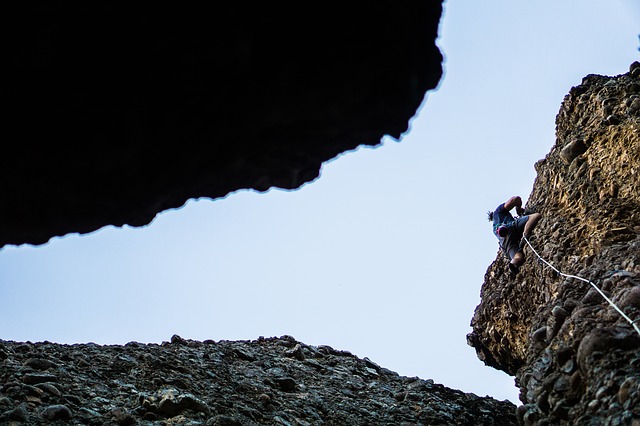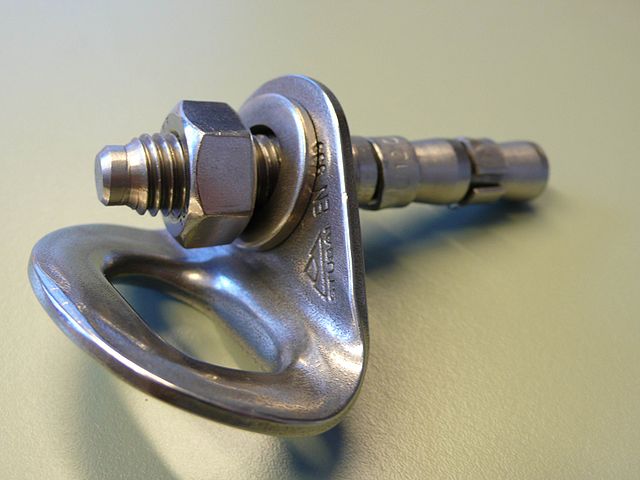Traditional climbing vs sport climbing, what’s the difference.

Trad climbing and sport climbing are two very different artforms. Trad focuses on slow, careful progression and puts safety first. Sport is all about hard moves, indomitable power, and turning up the try hard. Even though, sometimes, that means committing to a forty foot fall.

You might have just started in a local boulder gym or on a day outing with a more experienced friend. Maybe you just bought your first pair of shoes and chalk bag. Perhaps you’ve been crushing plastic holds for a while now.
No matter how you found rock climbing though, you will eventually make your way outdoors onto real rocks, the stuff where it all began. As soon as you’re outside the safety of gyms, fixed ropes, and crash pads, safety becomes the number one concern. How do you stay safe on your own while you’re out exploring natural rock faces.
How do you protect yourself outdoors?
There isn’t just one answer to that question. In fact, there are two, more or less. If you’re climbing on a rope, you’ll either be sport climbing or trad climbing, and the difference is huge.

Here is a breakdown of the two major types of roped climbing and where the difference originated.
Trad climbing, how it all began
Trad climbing, or traditional climbing, is just what it sounds like, the original way to protect yourself while scaling a wall. In trad climbing, you carry up protective equipment of various sorts.
You put gear in cracks, openings in the rocks, or around features like trees or boulders. After all, when the first pioneers of rock climbing walked up to a face, there were no bolts. They had to bring all their protection up with them.

These days climbers use high tech camming devices known as ‘cams’ or ‘friends’ as well as shaped nuts made of metal alloys that are lightweight and durable.

All sorts of tools have been invented and used as protection over the last six decades. Some we still use today. However, some are just tools of the past. I often climb past old petons wedged into cracks that will likely stay there for decades to come.
What trad is all about
Trad climbing is dangerous and requires knowledge, skill, training and endurance. This is not how you dip your toes into outdoor climbing.
Aside from the gear being quite expensive, it also requires extensive knowledge and practice to learn to use it correctly. If you place a piece of protection incorrectly, it might not hold your weight if you fall. Many climbers, have been injured or killed because they did not use traditional gear correctly and fell from a climb.

When you climb a trad route, you follow a crack, seam or line of weakness in the rock face. As the leader ascends the climb, they place a piece of gear every five to twenty feet. Placement depends on the circumstances, difficulty and available options.

As they place each piece of gear into the crack, they clip their rope on and continue climbing. Once they are at the top, the second climber usually follows and removes all the gear. This way, you never leave gear on the climb and you leave the rock the way you found it. All that changes is you.

Trad climbing opens up an entire world of possible routes and allows you to explore as far as the rock will take you. However, it is also the most serious and dangerous type of rock climbing.
If you want to learn to trad climb, find a friend who is skilled and experienced who can teach you. Or pay for classes with professional guides who can teach you the proper way to use gear.

The rewards are certainly worth the risks. Learn and practice patiently so that you’re always up for the challenges you choose. Trad climbing is truly the most adventurous form of climbing. It allows you to explore the most far out and remote places imaginable.
The history of sport climbing
Sport climbing developed long after trad climbing and evolved naturally from the meeting of technological development and growing ambition.
As climbers set their sights on harder and harder rock climbs in places like Yosemite Valley and Joshua Tree National Park, new inventions were allowing them to climb higher, faster and more safely. But no invention changed climbing more profoundly than the invention of the expansion bolt.

This allowed climbers to place bolts directly into the rock where there was no crack or available protection by traditional means. Climbers could now scale directly up blank faces.
Today, bolted lines lead up nearly every style of rock imaginable.

Climbing quickly evolved in the decades that followed as climbers tried harder and harder routes up seemingly blank walls. The ability to place bolts nearly anywhere they liked allowed the first sport climbers to push the limits of human capability without risking their lives the way the pioneers of the sport had.
What is involved in sport climbing
Unlike trad climbing, when you climb a sport route, there are already bolts in the rock where you will be climbing. The only gear you need to take up with you are quickdraws– clips that you use to attach your rope to the bolts as you go.

This not only reduces the amount of gear you have to buy and climb with, but it also increases the safety of the climbing. As long as the bolts are solid and in good shape, sport climbing is relatively low risk and easy to learn.
As a novice climber outdoors, sport climbing is definitely the most accessible and enjoyable way to start. The gear is relatively affordable and you’ll need it for trad climbing anyways.

You’ll become comfortable leading sport routes. You’ll learn the basics of rope management, knot-work, protection, rappelling, and mountain safety. Then, making the jump to traditional climbing will become more and more accessible and natural.

Whatever your end goal, climbing outdoors should be a part of it. Whether you aspire to high alpine summits or redpointing the hardest sport climbs around, you’ve got to start somewhere.
If you want to know what gear to get your hands on first, click here for a guide we’ve put together to help you out.
Have any comments? Please drop us a message on our Outdoor Revival Facebook page.
If you have a good story to tell or blog let us know about it on our FB page, we’re also happy for article or review submissions, we’d love to hear from you.
We live in a beautiful world, get out there and enjoy it.
Outdoor Revival – Reconnecting us all with the Outdoors
